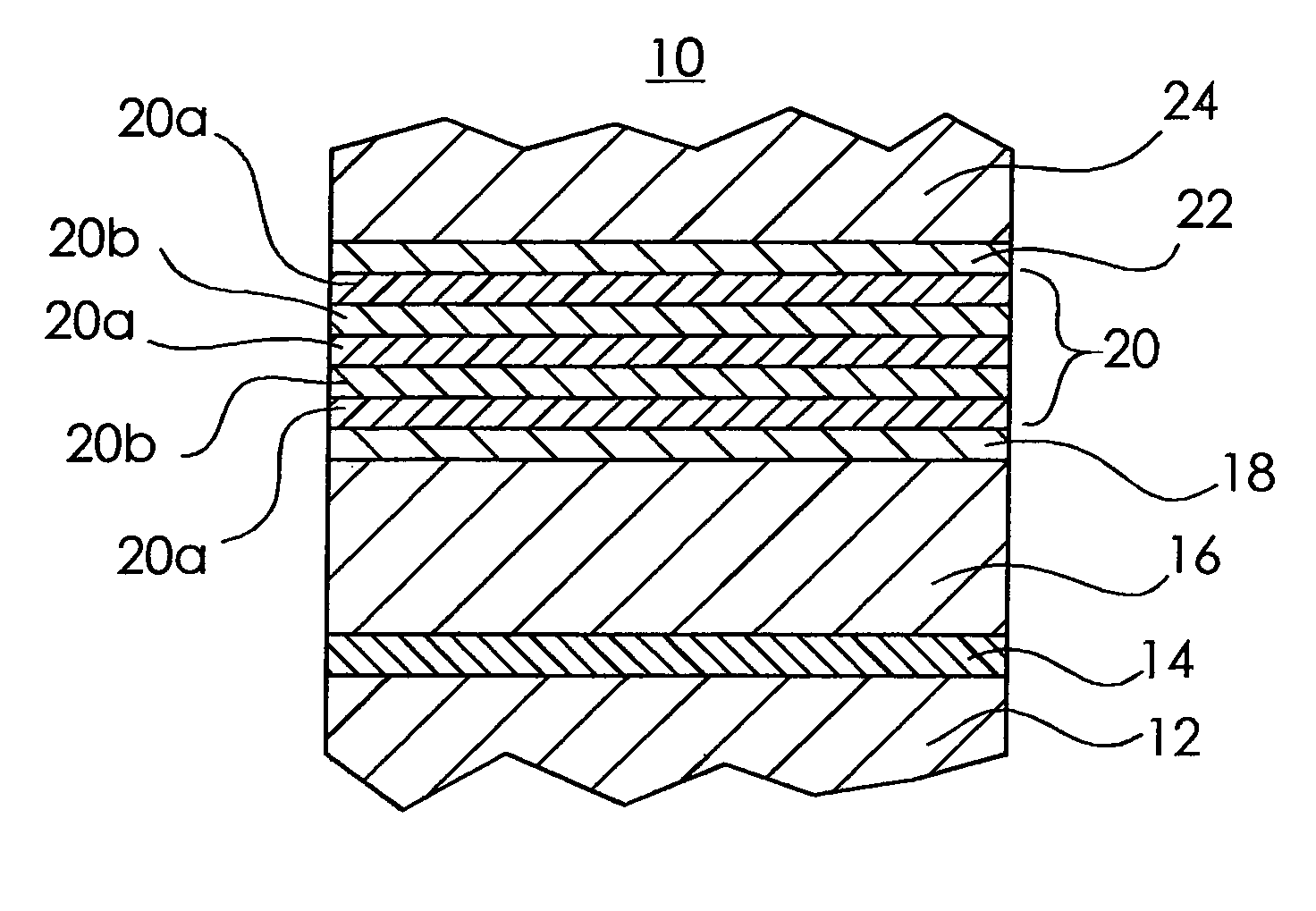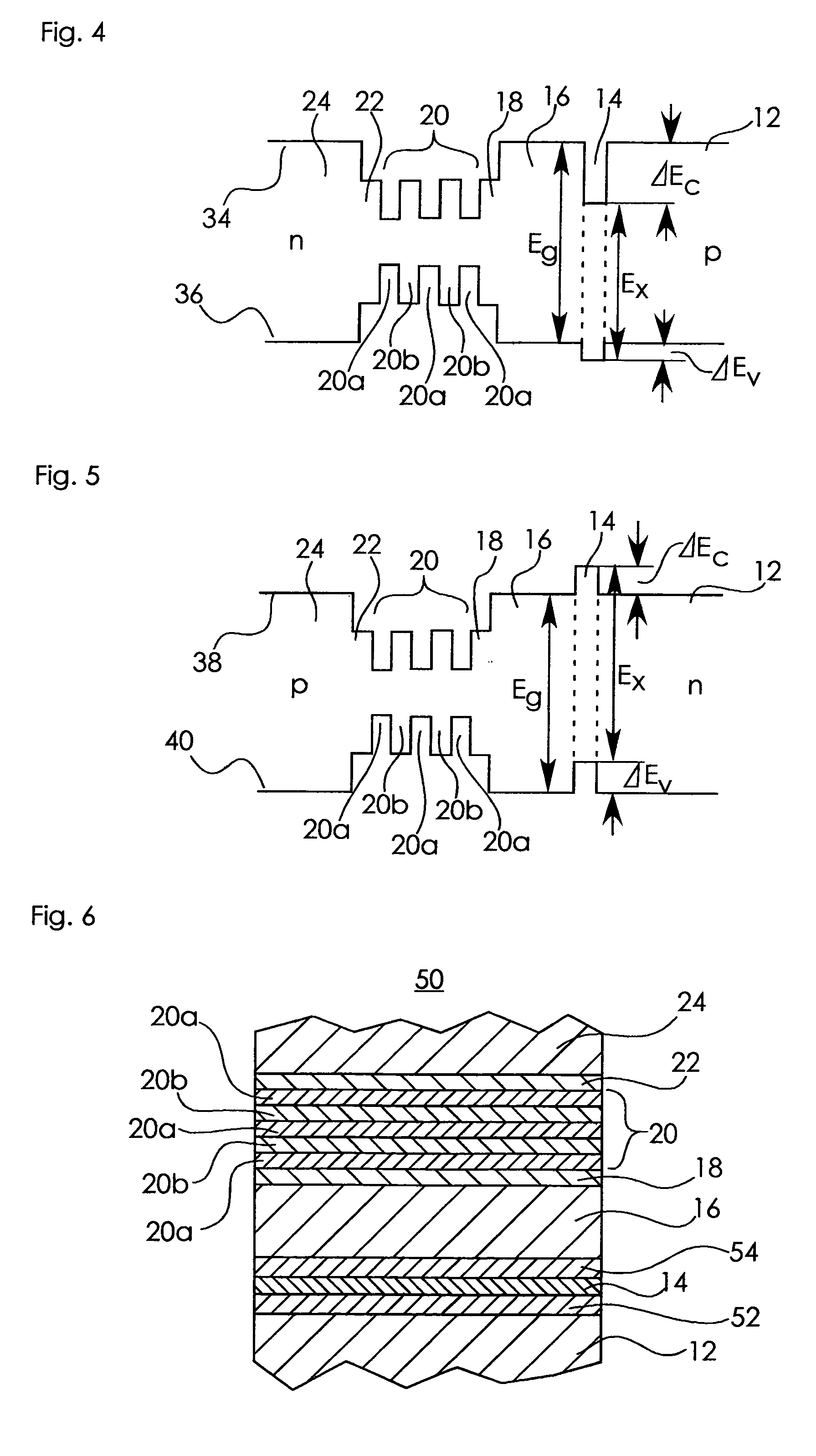Semiconductor laser device
a laser device and semiconductor technology, applied in the direction of lasers, semiconductor lasers, laser optical resonators, etc., can solve the problems of reducing luminous efficiency and increasing the threshold current of laser oscillation, and achieve high carrier concentration, small threshold current, and high luminous efficiency
- Summary
- Abstract
- Description
- Claims
- Application Information
AI Technical Summary
Benefits of technology
Problems solved by technology
Method used
Image
Examples
first embodiment
[0026]FIG. 1 is a cross-sectional view of a portion of a semiconductor laser device according to an embodiment of the present invention, the portion including an active layer and its neighborhood and having an optical waveguide laminated structure. It should be noted that in the following figures, like numerals will be used to denote like components.
[0027]FIG. 2 is a diagram showing the energy bands of the optical waveguide laminated structure shown in FIG. 1.
[0028]Referring to FIG. 1, a double heterojunction layer 14 is disposed on a first first-cladding layer 12, and a second first-cladding layer 16 is disposed on the double heterojunction layer 14. The first first-cladding layer 12 is made up of a p-type InP layer and acts as a first semiconductor layer (p-type and n-type are hereinafter abbreviated as “p-” and “n-”, respectively); the double heterojunction layer 14 is made of p-AlGaInAs and acts as a fourth semiconductor layer; and the second first-cladding layer 16 is made up o...
second embodiment
[0070]FIG. 6 is a cross-sectional view of a portion of a semiconductor laser device according to an embodiment of the present invention, the portion including an active layer and its neighborhood and having an optical waveguide laminated structure. FIG. 7 is a diagram showing the energy bands of the optical waveguide laminated structure shown in FIG. 6.
[0071]The basic configuration of the optical waveguide laminated structure 50 of the present embodiment is the same as that of the optical waveguide laminated structure 10 of the second variation (of the first embodiment). However, the optical waveguide laminated structure 50 is different from the optical waveguide laminated structure 10 of the second variation (of the first embodiment) in that the optical waveguide laminated structure 50 includes band discontinuity alleviating layers both between the first first-cladding layer 12 and the double heterojunction layer 14 and between the double heterojunction layer 14 and the second firs...
third embodiment
[0087]FIG. 9 is a cross-sectional perspective view of a portion of a semiconductor laser according to an embodiment of the present invention. FIG. 10 is a cross-sectional view of the semiconductor laser shown in FIG. 9 taken along line X—X.
[0088]Specifically, FIG. 9 shows a cross section of a distributed feedback semiconductor laser (hereinafter referred to as a DFB laser) 70 taken along a line in the optical waveguide direction (the x-axis direction); the semiconductor laser is symmetrical about this line. FIG. 10 shows a cross section of the DFB laser 70 taken along line X—X in the y-axis direction.
[0089]The DFB laser 70 is characterized in that its oscillation wavelength depends on the period of the diffraction grating and it can generate single-mode oscillation. This laser is also used for communications.
[0090]Referring to FIGS. 9 and 10, a first first-cladding layer 12 made up of a p-InP layer is disposed on a p-InP substrate 72 (the semiconductor substrate), and a double heter...
PUM
 Login to View More
Login to View More Abstract
Description
Claims
Application Information
 Login to View More
Login to View More - R&D
- Intellectual Property
- Life Sciences
- Materials
- Tech Scout
- Unparalleled Data Quality
- Higher Quality Content
- 60% Fewer Hallucinations
Browse by: Latest US Patents, China's latest patents, Technical Efficacy Thesaurus, Application Domain, Technology Topic, Popular Technical Reports.
© 2025 PatSnap. All rights reserved.Legal|Privacy policy|Modern Slavery Act Transparency Statement|Sitemap|About US| Contact US: help@patsnap.com



